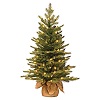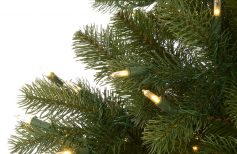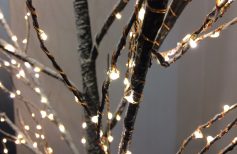All you need to know about artificial Christmas trees. Ready in a couple of minutes
So, you’ve decided to buy an artificial Christmas tree, and you’re asking the age old question: how do I make my choice? And above all, why is it that if there are two apparently equivalent Christmas trees, both of the same height, one costs twice as much as the other?
Well, if you have the patience to follow me in this article, I guarantee that within 10 minutes, you’ll become an expert in artificial Christmas trees.
Artificial Christmas trees, equal in colour, height and type of tree, have different prices and quality, mainly for three reasons:
- The materials the trees are made from, classic PVC, or POLYETHYLENE, which is also called REAL FEEL
- Number of spikes
- Type of assembly, or opening of branches
Before talking about these 3 basic characteristics, which all determine the price of the tree, let’s focus on the “type”. There are actually trees that are GREEN, those of other colours, FROSTED trees (that is, those sprinkled with snow) or SNOW trees, which appear to be full of snow, as if they’ve just been out in a heavy snowfall. Then there are trees that simulate the various autumnal colours of conifers, so they’re not only green, but brown, or tending towards orange-yellow.
These trees can then be sub-divided into:
- SLIM or REGULAR
- of STANDARD HEIGHT IN SOIL, or with ROOTS UNDER SOIL.
SLIM trees have a diameter at the base that’s slightly less than the traditional triangular shapes, therefore, while maintaining an excellent effect, they are much less cumbersome for the same height. For this reason they are the most often requested, because, although less realistic, they solve the space problem in surroundings that aren’t very spacious.
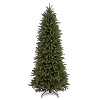
As for the STANDARD HEIGHT IN SOIL trees, or as they say “Roots in soil”, it’s a matter of taste: in the former case, the base of the tree is exposed, which is often unattractive, so gets covered and decorated with a special material or coloured paper, but there is one great advantage – and that is, WE CAN PUT GIFTS UNDER THE CHRISTMAS TREE!
If instead, we choose a tree that is full height, that is with the roots in soil, we have solved the problem of an unsightly appearance. But we will have a less realistic-looking tree, and we’ll only be able to put the gifts close to the tree, but not underneath it!
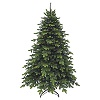
Clear so far? I think so. We then come to the famous 3 basic features I mentioned at the start of this article:
- MATERIALS: traditional synthetic trees are made of PVC. A machine produces the branches, which are then assembled one by one. The realistic effect is not optimal, and this is the main criticism in recent years against synthetic trees compared to traditional ones: from far away they can be cute, but close up, they don’t compare to real ones. However, for some time now, trees have appeared on the market that have their branches moulded in polyethylene. These trees are EXTREMELY REALISTIC, practically identical to real ones; and are even called REAL FEEL. Even to the touch they feel like a real fir tree, have three-dimensional twigs, as well as needles, and even sting a bit, just like real trees do. This technology, however, is much more expensive than the traditional type, so expensive that often the POLYETHYLENE trees are actually MIXED, that is, they have only the external branches made with the new technology, while the inner ones, which are more hidden, that are only there for colour and volume, are still made of PVC.
- NUMBER OF POINTS: or, as reported on some packaging, the number of branches. In reality it is always the TOTAL number of points of the tree. This is a very important factor, for two reasons:
- the thicker the number of points, the more full, thick and therefore beautiful the tree is.
- even on websites, as in stores, trees with few tips are opened incorrectly, that is, opening all the tips of each branch as if it were the petals of a flower, to visually fill the gaps due at the low number of branches. This results in a rather ugly effect, because it is NOT REALISTIC! In nature, the branches of the firs, larches and pines appear “fan-shaped”. But if we open a tree with a few tips in this way, we will get a dishevelled effect.
- TYPE OF ASSEMBLY:
- with branches that have to be hooked to the trunk one by one. Usually the various branches have markings of a different colour for each crown of branches, so as not to be mistaken. As you can imagine the assembly is long and arduous.
- with umbrella branches. The branches in this case are already hooked to the trunk, they are simply opened one by one and … I recommend, you always start from the bottom upwards!
- Self-mounting: yes, you got it right! There are trees with branches that don’t open like an umbrella but have SHAPE MEMORY instead, that is, they maintain a given shape. All you need to do is take the tree out of the box, put it upright and leave it, you’re done! The system opens up to the tips and within 5 minutes, you have your beautiful tree!
Finally, we add two features that should never be underestimated.
There are trees that already have LED LIGHTS inserted on each branch. You got it right! You don’t need to purchase any lights separately. So no effort is needed, untangling a string of lights to mount around the tree, to hide it among the branches … Not to mention that nowadays, a good set of indoor led lights (1000-1500 MULTI-COLOUR LED LIGHTS) doesn’t cost less than 60-80 euros. In these cases, the tree already has electrical contacts inside the trunk, which is often divided into several parts, so through a very precise “bayonet” coupling, you just assemble the 2/3 part, plug it in and you’re finished!
The latest novelty for anyone who, in addition to the traditional effects of LED control units, want the lights to turn on and off in time to music, are BLUETOOTH trees. In practice, you decorate the tree with the lights already inserted, you connect the unit to your phone and you’re done. Just load your favourite Christmas playlist and the lights will also dance to music.
And with that, I’ve told you everything! Now you’re a super expert too, you just have to choose the tree that’s best suited your needs and above all … to your budget.


